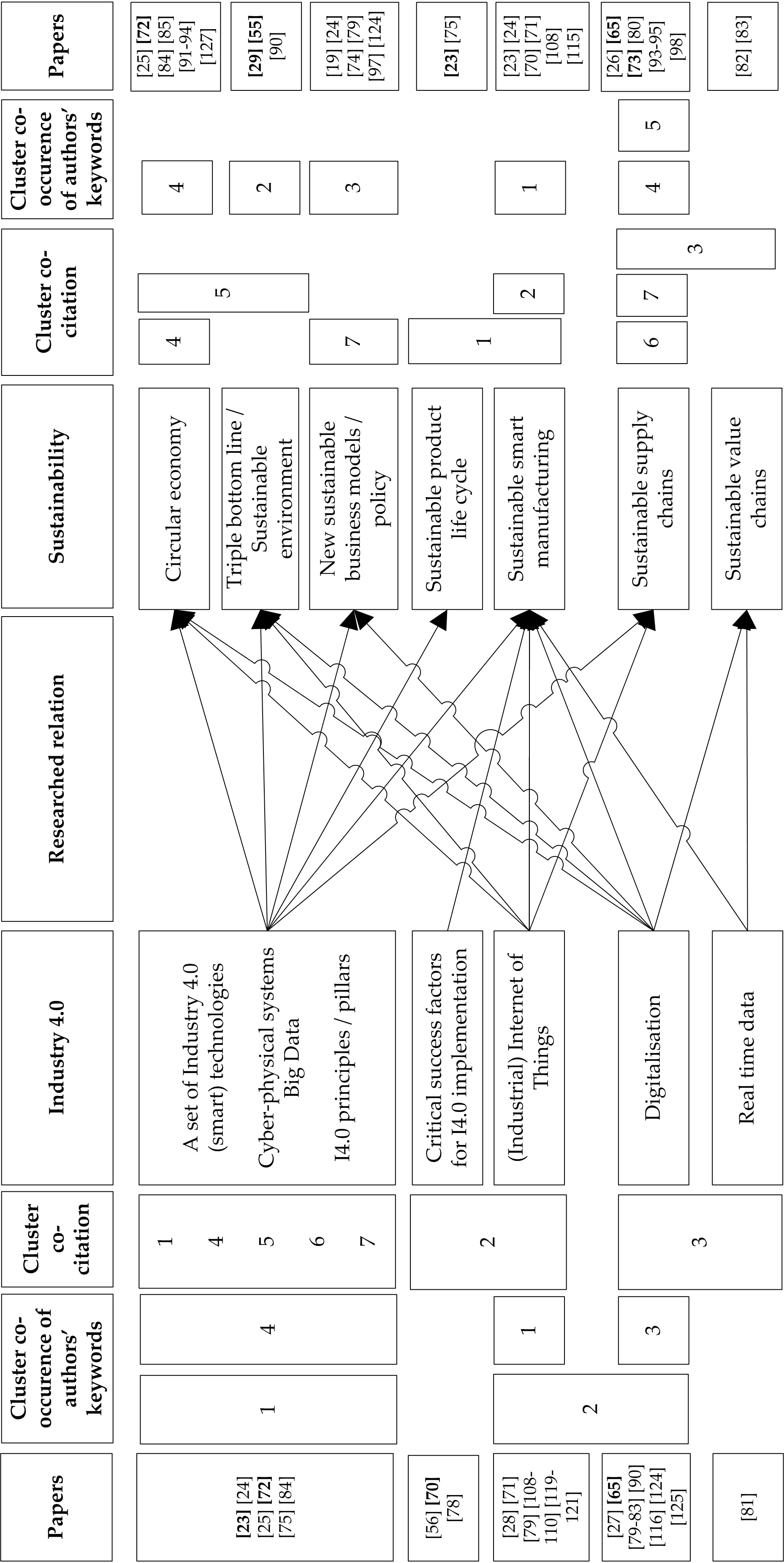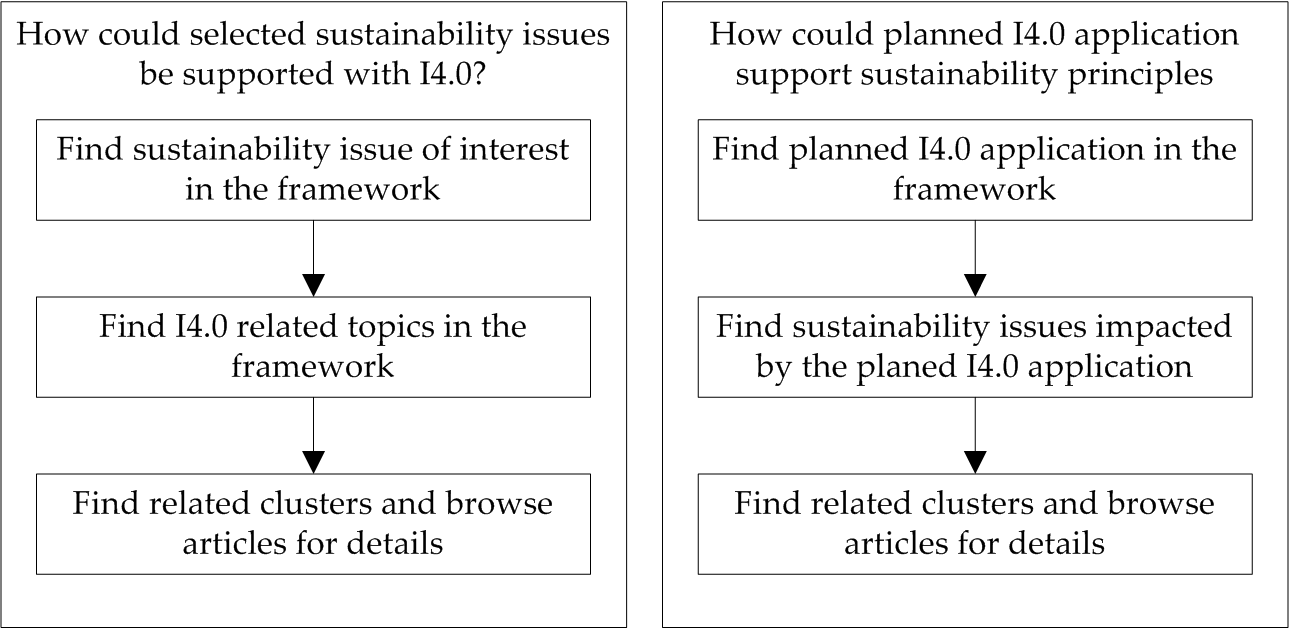Sustainability and Industry 4.0 (I4.0) are trending concepts used in the literature on industrial processes. Industry 4.0 has been mainly addressed by the current literature from a technological perspective, overlooking sustainability challenges regarding this recent paradigm. The objective of this encyclopedia entry is to evaluate the state of the art of relations between sustainability and I4.0. The goal will be met by (1) mapping and summarizing existing research efforts, (2) identifying research agendas, (3) examining gaps and opportunities for further research. Web of Science, Scopus, and a set of specific keywords were used to select peer-reviewed papers presenting evidence on the relationship between sustainability and I4.0. To achieve this goal, it was decided to use a dynamic methodology called “systematic literature network analysis”. This methodology combines a systematic literature review approach with the analysis of bibliographic networks. Selected papers were used to build a reference framework formed by I4.0 technologies and sustainability issues. The encyclopedia entry contributes to the Sustainable Industry 4.0 reference framework with application procedures. It aims to show how I4.0 can support ideas of sustainability. The results showed that apart from a huge contribution to both concepts, many papers do not provide an insight into realization of initiatives to introduce Sustainable Industry 4.0.
- industry 4.0
- sustainability
- literature review
- fourth industrial revolution
- bibliometrics
1. Introduction
Industry 4.0 (I4.0) as a term and strategic initiative of the German government was introduced in 2011 [1,2]. Many similar transforming actions towards Industry 4.0 were taken in other developed countries, e.g., US Advanced Manufacturing Partnership, Chinese Made in China, British Smart Factory and others [3]. I4.0 and smart manufacturing/factory (which are synonymous) are the natural consequence of the historical developments of computer integrated manufacturing and flexible manufacturing systems [4] from the past decades. However, nowadays, through advanced technologies those ideas of CIM (Computer-integrated manufacturing) and FMS (Flexible manufacturing system) could be further developed and implemented at lower costs. Speaking of Industry 4.0, it should be considered as the applying of flexible automation, cyber-physical systems, (industrial) Internet of Things, sensors, collaborative and cognitive robotics, cloud computing, big data, computer modelling and simulations, additive manufacturing (3D printing) [5]. This picture clearly shows the technology-driven nature of I4.0 on the one hand. On the other hand, businesses are expecting great benefits:
-
economic, e.g., savings through more accurate planning, shorter lead times, increase of energy efficiency;
-
environmental, e.g., increase of energy efficiency, decrease of manufacturing scrap waste, etc.;
-
social, e.g., increase of safety, more comfortable working environment, etc.
-
economic, especially the cost-intensive nature and difficulties with estimation of full financial benefits and economic effectiveness (what could be approached with one of I4.0 technologies: computer simulation modelling);
-
environmental, e.g., increase of electro-waste, increase of energy consumption;
-
social, e.g., human-robot interaction issues, unemployment threats, privacy issues.
-
realize the unique challenges of Industry 4.0;
-
create a sustainable industrial environment;
-
enhance its impact in the literature and business area.
Industry 4.0 as a contributor to the Sustainable Development Goals (SDGs) [11] builds connectivity between the industry and sustainability by finding a significant relation between their components. The main efforts are, therefore, related to the tools and methods used for the comprehensive analysis of these terms. Much research or state-of-the-art reviews have been already done by researchers, separately for sustainability and Industry 4.0 phenomena [12,13]. A systematic literature review of Industry 4.0 resulting in modelling relationships between sustainability functions and Industry 4.0 was presented in [14], while [15] proposed a new concept of Sustainable Industry 4.0. As intended by the United Nations Sustainable Development Goals [11] for 2030, technological progress is driving the challenge of transition from traditional technology into intelligent machines without limiting the sustainability of the industrial economy. The combination of AI, robotics and other advanced technologies applied across many sectors of economy, e.g., the supply chain, distribution channels, manufacturing, provides a significant impact on the natural environment leading to reduction of pollution, decrease in greenhouse gases emission, decrease in energy consumption and increase in profits, simultaneously. The emergence of Industry 4.0 opens the opportunity of connectivity of technology with resources and skills in terms of sustainability benefits (zero impact—lower cost—social equity). Industry 4.0 can reduce the environmental impact of a product, a process, or a service based on footprint data availability and traceable analysis [16]. Additionally, it helps to leverage a greater efficiency of functions e.g., reduction of resource consumption. Therefore, Industry 4.0 might contribute sustainability to develop digital sustainable operations allowing to meet SDGs goals. Furthermore, increasing development of smart technologies is envisaged as affecting sustainability. The potential of Industry 4.0 is still existing with its unknown impact on other areas like socio-environmental sustainability [14] or making opportunities for realizing Industry 4.0 through intelligent systems.
2. Sustainable Industry 4.0 framework
Grounding on cluster analysis depicted in [1], the reference framework was constructed (Figure 1).
Figure 1. Sustainable Industry 4.0 reference framework based on SLNA from 2012–2019[1].
The goal of this framework is to serve as a kind of manual and guideline for Industry 4.0 applications supporting sustainability principles. The use of framework is based on selection of which sustainability issues are planned to be addressed or defined as critical by an organization. Then, search term is to be found in the framework and next, one may find which I4.0 topics and their relations with the selected sustainability issue were discussed in the literature. There is reference given to the clusters where more details, case studies, best practices could be found. The reverse procedure is applied if one is seeking for possible impacts of planned I4.0 applications on sustainability (Figure 2). After finding the cluster with the topics of interest, one may use GCS values to seek for the most prominent papers in the cluster and start own research from this point. In Figure 1, papers with the highest GCS are listed in bold. The list of papers is in [1].
Figure 2. Sustainable Industry 4.0 reference framework—application procedures[1].
The implication of the framework may result from the industrial use of emerging technologies distributing the sustainable value propositions in an Industry 4.0 environment. The Sustainable Industry 4.0 reference framework is divided into two separate application procedures which depict a logical order of activities of:
- how I4.0 implements selected ideas of sustainability;
- how sustainability principles are supported by planned I4.0 application.
The first procedure starts with finding out sustainability issues of interest and I4.0 related topics in the framework. Using the search, a network composed of linked clusters and articles can be received. In the second procedure a similar sequence of activities was applied. A group of related papers and related clusters that explore how principles are supported by planned I4.0 application may be found using browse.
The application of the sustainable Industry 4.0 reference framework needs to support the development of real-time data-based functions or systems addressing the specific industrial domain sectors. The interrelated elements of the framework provide synergy where processes, Industry 4.0 principles, digital platforms must be interfaced.
The presented framework is of a general nature, therefore it is applicable in a wide variety of organizations. Its strengths are simplicity, clarity and ease of use. However, for specific cases one may need to extend the framework and include details on a lower level, such as guidelines for particular I4.0 technologies or sustainability issues.
3. Discussion and Future Research Directions
-
RQ1. How applications of Industry 4.0 can contribute to sustainable development?
-
RQ2. How Industry 4.0 technologies and tools can be integrated into sustainability practices on a theoretical and practical basis?
-
RQ3. What are the main approaches/methodologies/frameworks/tools that should be considered for integrating Industry 4.0 with sustainable development?
This entry is adapted from the peer-reviewed paper 10.3390/su12145650
References
- Krzysztof Ejsmont; Bartlomiej Gladysz; Aldona Kluczek; Impact of Industry 4.0 on Sustainability—Bibliometric Literature Review. Sustainability 2020, 12, 5650, 10.3390/su12145650.


